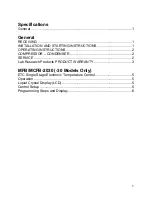
5
MFB/MCFB-2030
This section pertains to -30
°
C FREEZER ONLY
This freezer has been factory set to run at -30
°
C. The external thermostat may require
adjustment depending on the final ambient operating condition. The freezer has
reserve range and can operate to -35
°
C, depending on load and ambient
temperature. Plug into a standard 110-120 volt electrical outlet. The unit will start to
operate. It will require 5 amps. The freezer's operation will be extremely quiet due to
the unique design of the compressor system.
As with the –20 models, pre-cool unit before placing any product into the chamber. The
temperature will reach -30
°
C in less than four hours; however, let the chamber cool for 8
hours minimum to allow for total heat removal from the cabinet.
Again, this is a manual defrost system. If ice build up is present ¼ inch or more on the
fixed shelves, defrosting is recommended. Large ice build up will reduce cooling
efficiency.
If this system is equipped with a temperature display or alarm system it is not
uncommon to observe a rise in temperature on the display following a door opening.
Unless the door is left open for long periods of time this should not affect product
temperature. The temperature display is independent of the thermostat that is actually
controlling the off/on cycling of the compressor. Door opening will greatly affect air
temperature but generally does not affect product temperature.
ETC Single Stage Electronic Temperature
(-30 Models Only)
Operation
Liquid Crystal Display (LCD)
The LCD display provides a constant readout of the sensor temperature and indicates if the output rely is
energized. When the S1 annunciator is constantly illuminated during operation, the relay is energized.
The display is also used in conjunction with the keypad to allow the user to adjust the setpoint
temperature, differential and heating/cooling modes.
Control Setup
The temperature setpoint refers to the temperature at which the normally open (NO) contacts of the
output relay will open. Determine the load(s) to be controlled and the operating mode required, cooling or
heating.
When the cooling mode is chosen, the differential is above the setpoint. The relay will de-energize
as the temperature falls to the setpoint.
When the heating mode is chosen, the differential is below the setpoint. The relay will de-energize as
the temperature rises to the setpoint.


























